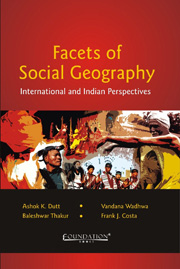Book contents
- Frontmatter
- Contents
- Foreword
- Preface
- Acknowledgements
- List of Contributors
- I Introductory Framework: Allen G. Noble's Contribution to Social Geography
- II Conceptual and Theoretical Basis of Social Geography
- III Social Geography from a Global Perspective
- IV Social Geography in the Indian Context
- V Indian Social Geography: City and State Context
- 24 Health Infrastructure and Healthcare Services in Uttar Pradesh
- 25 Status of Women in Aligarh Muslim University, India
- 26 Social Geographies of Collective Action: A Case Study of India's Chipko Movement
- 27 Sacredscape and Manescape: The Sacred Geography of Gaya, India
- 28 Madurai: A Holy City of Pilgrimage
- 29 Assessment and Dynamics of Urban Growth in the City of Kolkata
- 30 Socioeconomic and Demographic Conditions of the Slums of Hyderabad
- 31 Writings of Mirza Ghalib: A Study in Literary Geography
- 32 Geographic Images of Old Delhi through Literature
- 33 Spatial and Temporal Characteristics of Elite Residential Colonies in Delhi, 1982–2004
- Index
26 - Social Geographies of Collective Action: A Case Study of India's Chipko Movement
from V - Indian Social Geography: City and State Context
Published online by Cambridge University Press: 05 June 2012
- Frontmatter
- Contents
- Foreword
- Preface
- Acknowledgements
- List of Contributors
- I Introductory Framework: Allen G. Noble's Contribution to Social Geography
- II Conceptual and Theoretical Basis of Social Geography
- III Social Geography from a Global Perspective
- IV Social Geography in the Indian Context
- V Indian Social Geography: City and State Context
- 24 Health Infrastructure and Healthcare Services in Uttar Pradesh
- 25 Status of Women in Aligarh Muslim University, India
- 26 Social Geographies of Collective Action: A Case Study of India's Chipko Movement
- 27 Sacredscape and Manescape: The Sacred Geography of Gaya, India
- 28 Madurai: A Holy City of Pilgrimage
- 29 Assessment and Dynamics of Urban Growth in the City of Kolkata
- 30 Socioeconomic and Demographic Conditions of the Slums of Hyderabad
- 31 Writings of Mirza Ghalib: A Study in Literary Geography
- 32 Geographic Images of Old Delhi through Literature
- 33 Spatial and Temporal Characteristics of Elite Residential Colonies in Delhi, 1982–2004
- Index
Summary
The Chipko movement is popularly recognized as the most famous and successful environmental movement in India's history. The term ‘chipko’ is commonly translated from Hindi as ‘hug’ or ‘embrace’ and it refers to a method of protest in which one embraces a tree in order to prevent its felling (Right Livelihood Awards (RLA), 1987; Karan, 1994). The contemporary Chipko movement is best known for a string of protests that began in the 1970s, which most prominently involved an increasingly large number of peasant women. The majority of these protests occurred in the Himalayan foothills in the region of Uttarakhand (Fig. 26.1). A majority of the Indian Himalayas lie in this region, which borders both Nepal and Tibetan China. As two of the most heavily forested states in India, Uttarakhand (formerly Uttaranchal) and Uttar Pradesh have long been relied upon for their supplies of natural resources, which have been regarded as critical to national economic development (RLA, 1987). While organized resistance against restrictive and unjust economic devel- opment and environmental policies have occurred elsewhere in India, the materialization and manifestation of the Chipko movement reflects the specific multi-scalar social, political and ecological processes which constituted social life in the late 1960s Uttarakhand, and which was itself later reshaped by these distinctive patterns of struggle.
This case study examines Chipko movement activity at the specific regional scale of Uttarakhand in order to examine how social movements emerge from spatially-embedded power relations and social contexts.
- Type
- Chapter
- Information
- Facets of Social GeographyInternational and Indian Perspectives, pp. 483 - 501Publisher: Foundation BooksPrint publication year: 2012



